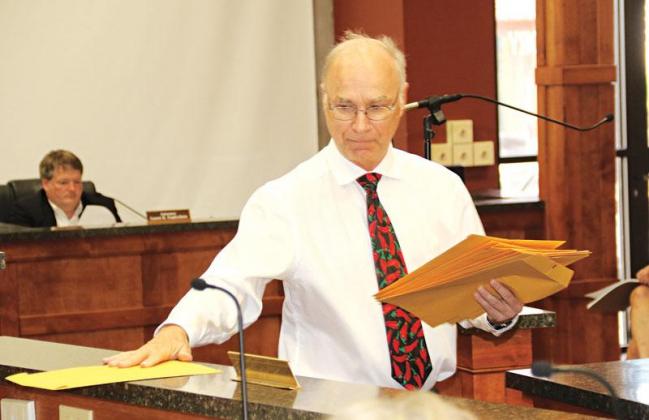
Harlan Kirgan
The Opelousas Rotary Club is asking the St. Landry Parish Council’s permission to place a statue of Saint Landry in front of the parish courthouse.
“Saint Landry was a very important saint to the French people. He was one of the most important saints for the city Paris,” Rotary Club member Bruce Gaudin said in a presentation to the Council on Wednesday.
The statue of Saint Landry is a centennial project for the Rotary Club, which is to celebrate its 100th year in 2022, he said.
“Our plan is to do a bronze statue kind of similar to this one for Evangeline,” Gaudin said as he showed a photo of the Evangeline statue at the Evangeline Parish Courthouse.
This is a perilous time for public statues and Council member Jerry Red said there needs to be research on Saint Landry before it is placed. “We just want to make sure,” he said.
Statues of historical figures are being removed across the nation, particularly those related to slavery.
The Rotary Club has raised $32,000 for the statue and is continuing its funding effort Gaudin said.
“He was very well known for being a man of the people. Not somebody that you would look up at, but somebody you could sit down with or somebody that would help you and that’s what he did in the 650s,” Gaudin said of Saint Landry.
An artist in New Orleans, Kim Bernadas, has agreed to do the sculpture, he said.
The statue will depict Saint Landry seated on a granite block with a description of who he was.
The statue would be informational and a tourist attraction, he said.
“Can you imagine how many Landrys there are in the world?” he said.”People who are Landrys are going to come to sit down next to Saint Landry. People from all over Louisiana and all over the world I think would like to come to St. Landry Parish. They should know who Saint Landry is.”
Whenever the name Saint Landry was picked for the parish “they knew Saint Landry. He was very dear to them.”
The statue proposal was presented to the Public Works Committee, which voted to send it to the full Council in two weeks.
The following is history of Saint Landry that Gaudin presented to the Council.
Saint Landry was the chief clerk at the Royal Chancellery when he succeeded Andrebert to become the 28th bishop of Paris in 650A.D. He served as bishop in the Frankish kingdom (formally Gaul), during the reign of Clovis II until his death in 661. His feast day is celebrated on June 10th.
Saint Landry was a very earnest and devout man, and since infancy gave himself completely to Christ. He was a very learned man of high principles, distinguishing himself especially by his great love of the poor. He labored zealously to improve their lot. During the plague, aggravated by the famjne of 650, he sold all of his possessions to relieve the sufferings and feed the poor people of Paris. When this did not suffice to relieve their hunger, he also sold some of the furniture and sacred vessels of the Church.
In 651A.D., St. Landry founded the city’s first real hospital. He erected the hospital near the Cathedral of Notre Dame, on the site of the palace of his benefactor Erchinoaldus and dedicated the hospital under the name of St. Christopher, which subsequently developed into the great institution, famous even today, known as Hotel-Dieu de Paris.
Attesting to the significant role St. Landry played in early Paris, there is a chapel dedicated to him near and adjacent to the main altar in the church of St. Germain L’Auxerrois of Paris. On the walls of the chapel are three magnificent frescos depicting the selling of valuables of the Church for the poor, founding the hospital with the help of Monks, and one of the Glorification of St.Landry. There is also a magnificent icon depicting the Crucifixion of Christ with four Saints. St. Landry stands directly on the left side of Christ.
